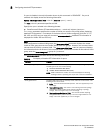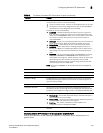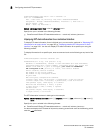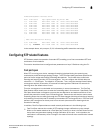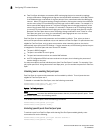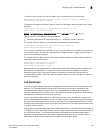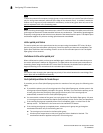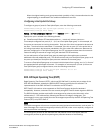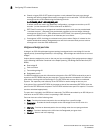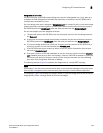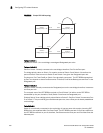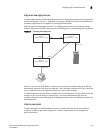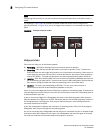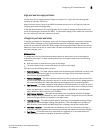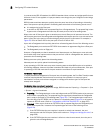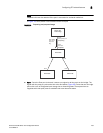
228 PowerConnect B-Series FCX Configuration Guide
53-1002266-01
Configuring STP related features
8
• Classic or legacy 802.1D STP protocol requires a newly selected Root port to go through
listening and learning stages before traffic convergence can be achieved. The 802.1D traffic
convergence time is calculated using the following formula.
2 x FORWARD_DELAY + BRIDGE_MAX_AGE.
If default values are used in the parameter configuration, convergence can take up to 50
seconds. (In this document STP will be referred to as 802.1D.)
• RSTP Draft 3 works only on bridges that have Alternate ports, which are the precalculated
“next best root port”. (Alternate ports provide back up paths to the root bridge.) Although
convergence occurs from 0 – 500 milliseconds in RSTP Draft 3, the spanning tree topology
reverts to the 802.1D convergence if an Alternate port is not found.
• Convergence in 802.1w bridge is not based on any timer values. Rather, it is based on the
explicit handshakes between Designated ports and their connected Root ports to achieve
convergence in less than 500 milliseconds.
Bridges and bridge port roles
A bridge in an 802.1W rapid spanning tree topology is assigned as the root bridge if it has the
highest priority (lowest bridge identifier) in the topology. Other bridges are referred to as non-root
bridges.
Unique roles are assigned to ports on the root and non-root bridges. Role assignments are based
on the following information contained in the Rapid Spanning Tree Bridge Packet Data Unit (RST
BPDU):
• Root bridge ID
• Path cost value
• Transmitting bridge ID
• Designated port ID
The 802.1W algorithm uses this information to determine if the RST BPDU received by a port is
superior to the RST BPDU that the port transmits. The two values are compared in the order as
given above, starting with the Root bridge ID. The RST BPDU with a lower value is considered
superior. The superiority and inferiority of the RST BPDU is used to assign a role to a port.
If the value of the received RST BPDU is the same as that of the transmitted RST BPDU, then the
port ID in the RST BPDUs are compared. The RST BPDU with the lower port ID is superior. Port roles
are then calculated appropriately.
The port role is included in the BPDU that it transmits. The BPDU transmitted by an 802.1W port is
referred to as an RST BPDU, while it is operating in 802.1W mode.
Ports can have one of the following roles:
• Root – Provides the lowest cost path to the root bridge from a specific bridge
• Designated – Provides the lowest cost path to the root bridge from a LAN to which it is
connected
• Alternate – Provides an alternate path to the root bridge when the root port goes down
• Backup – Provides a backup to the LAN when the Designated port goes down
• Disabled – Has no role in the topology



